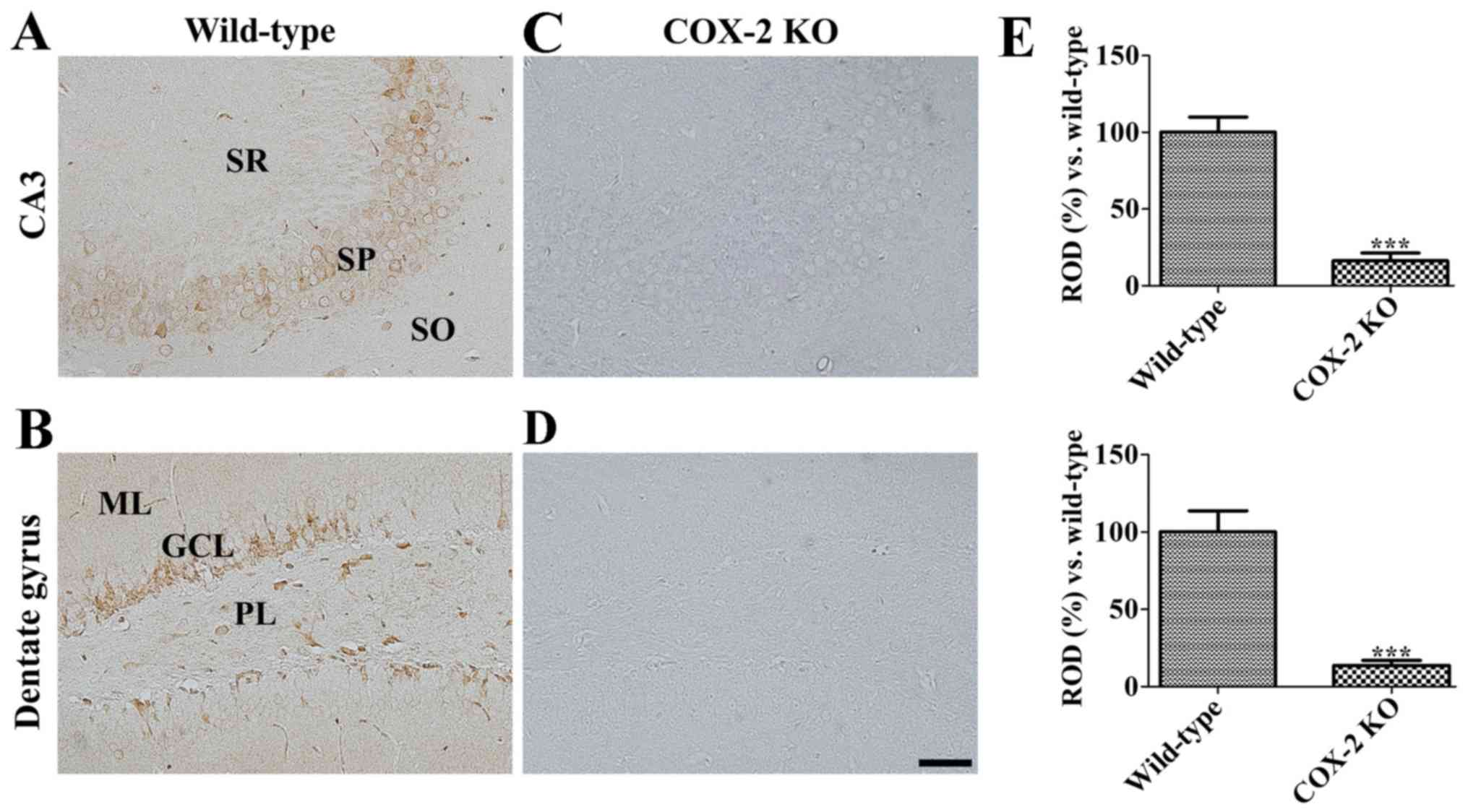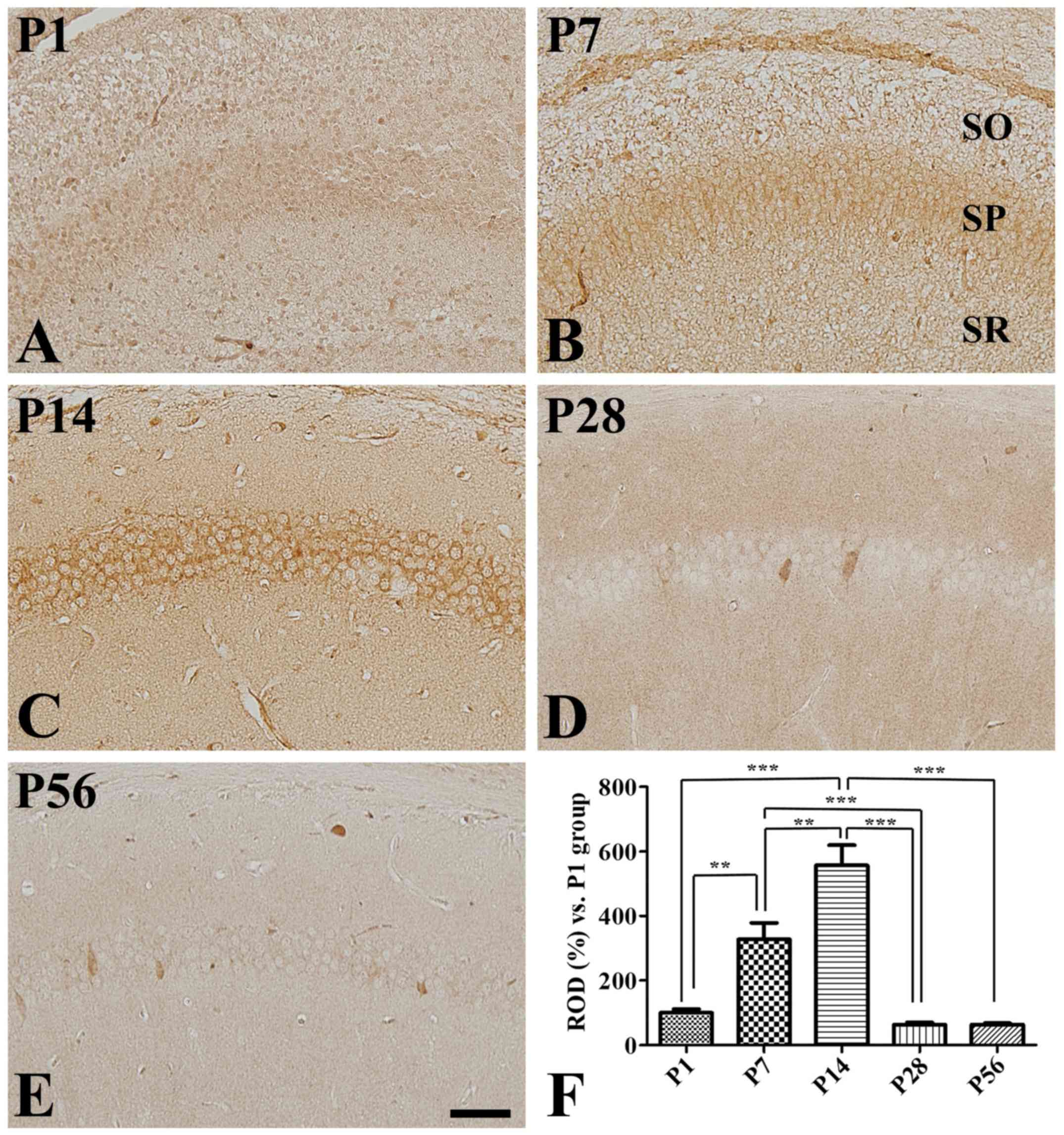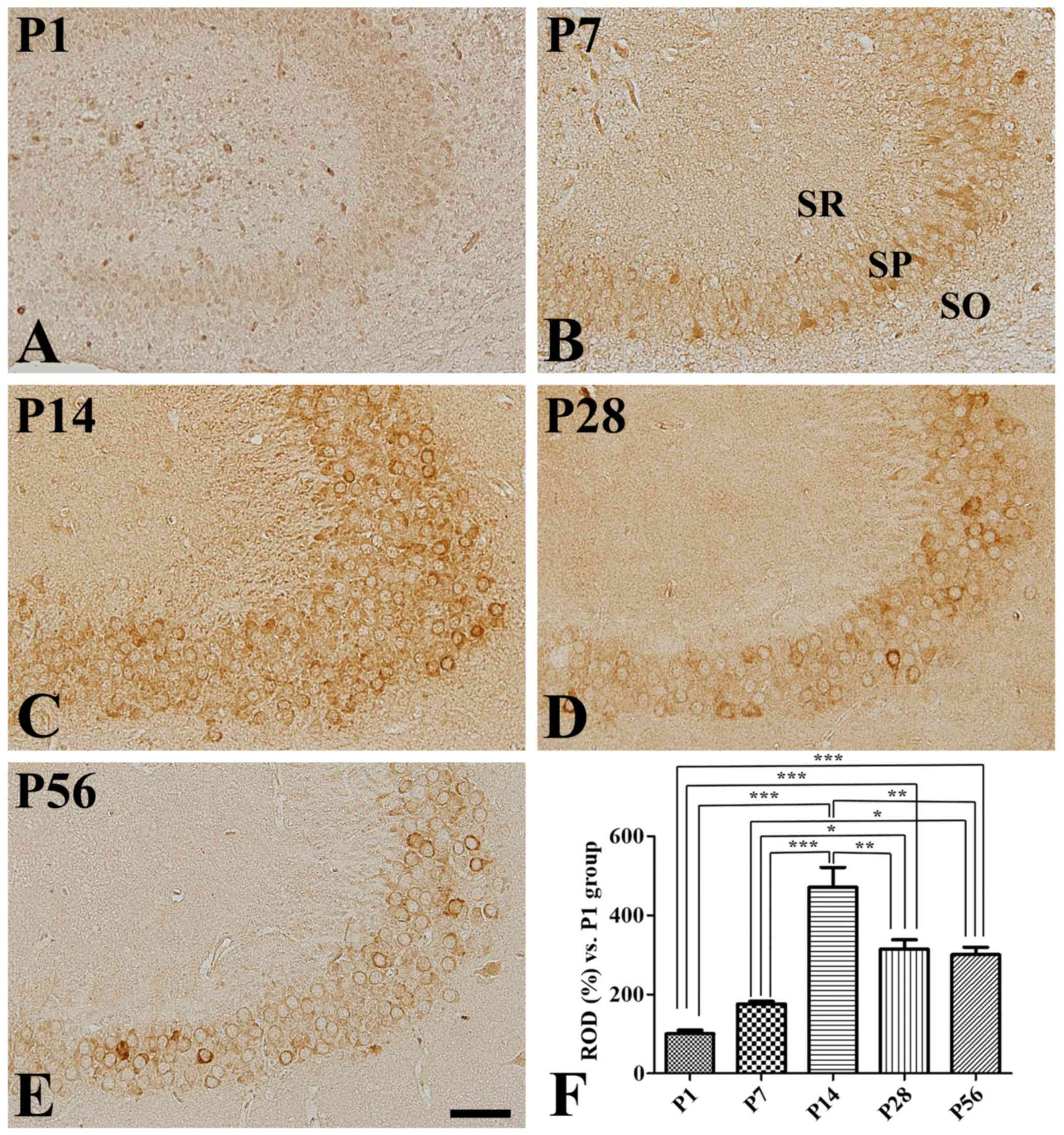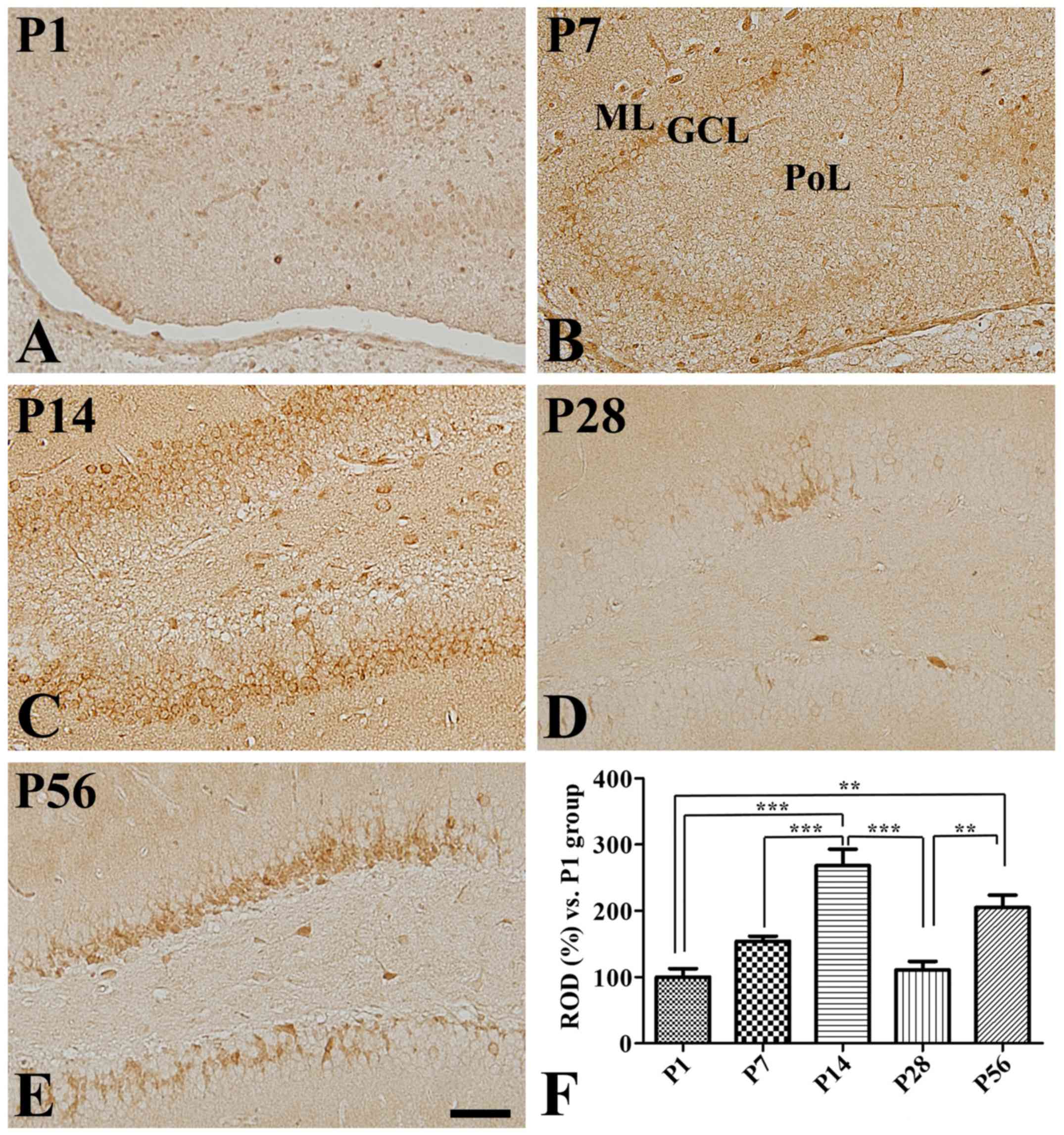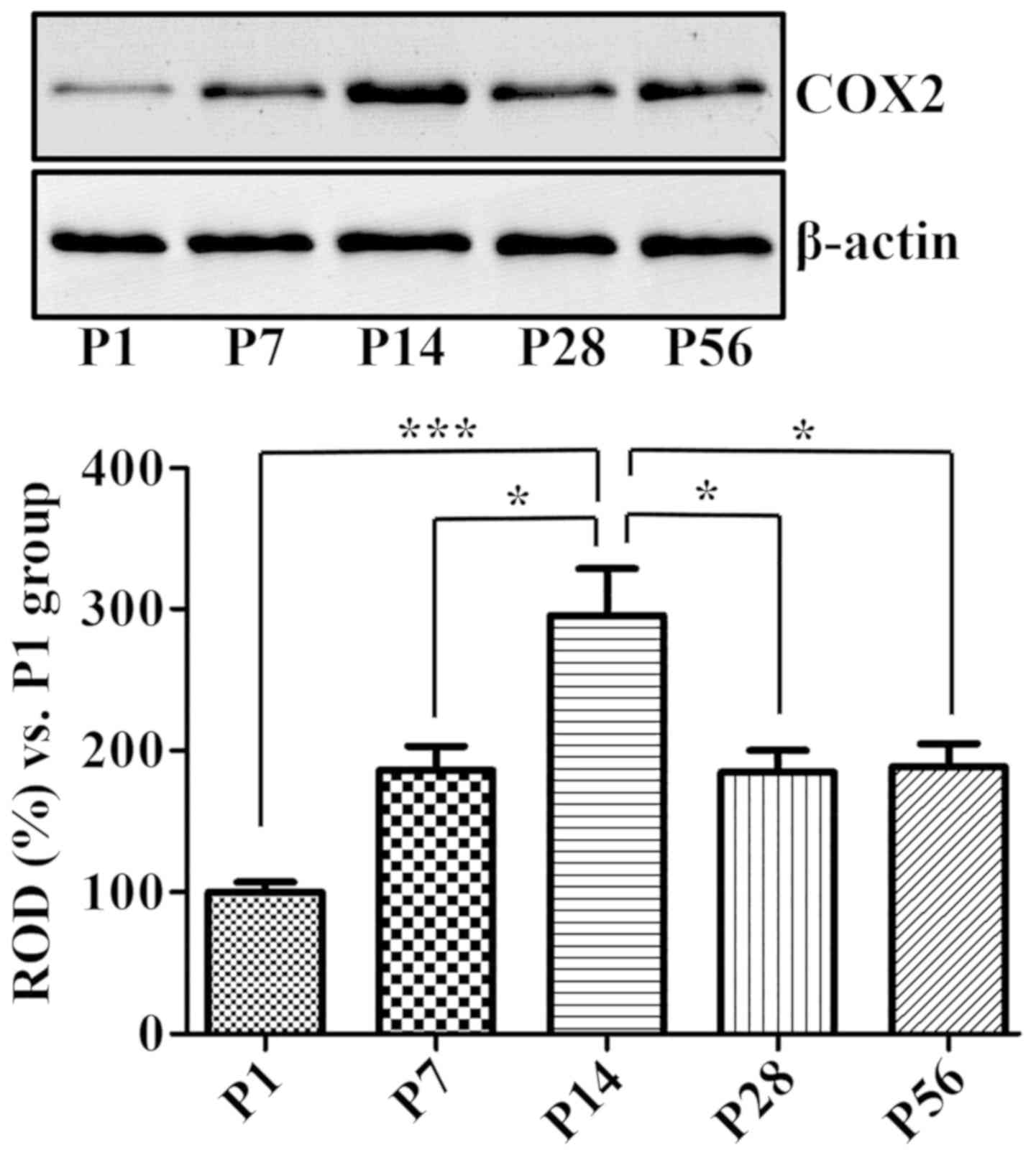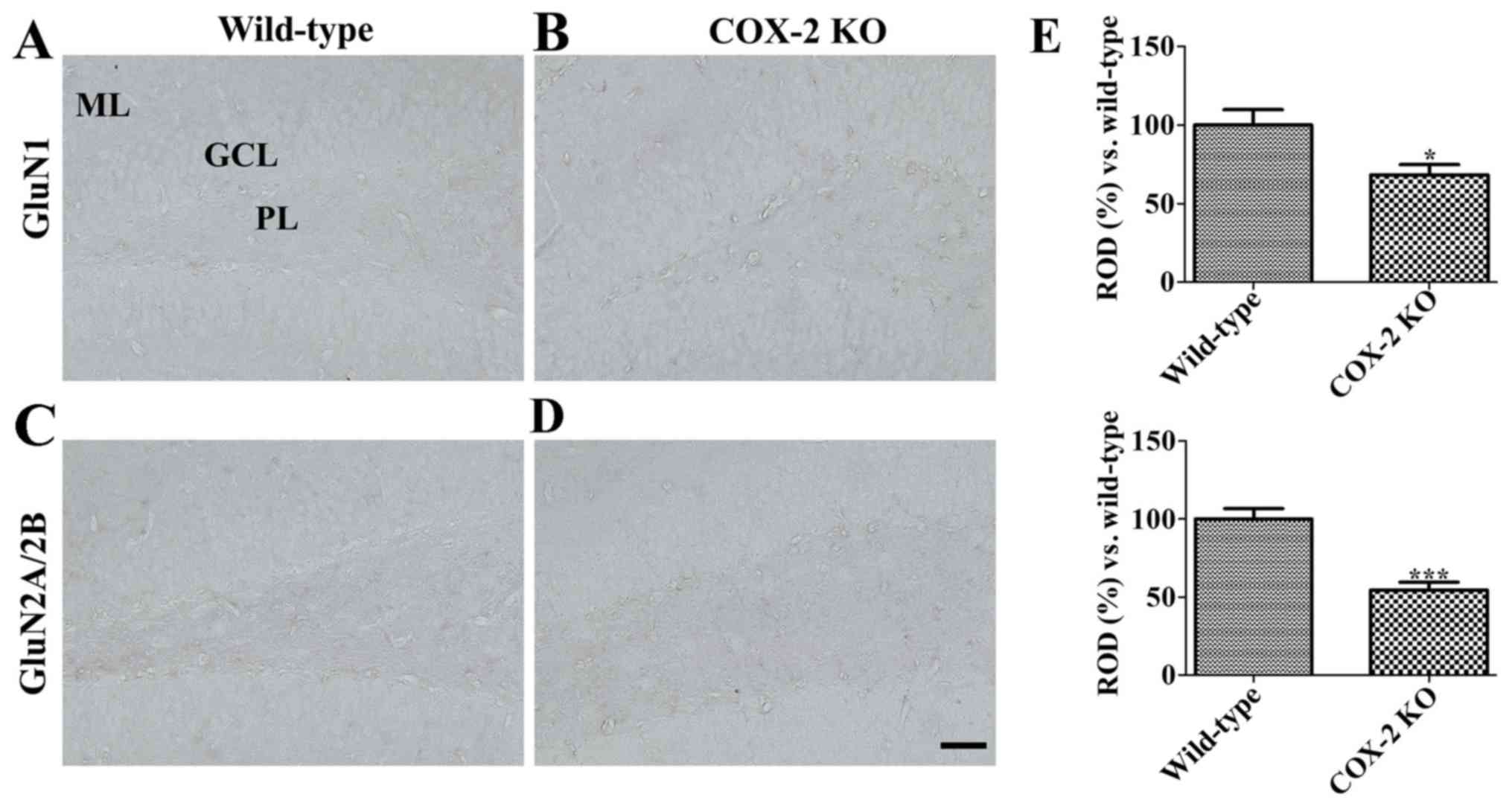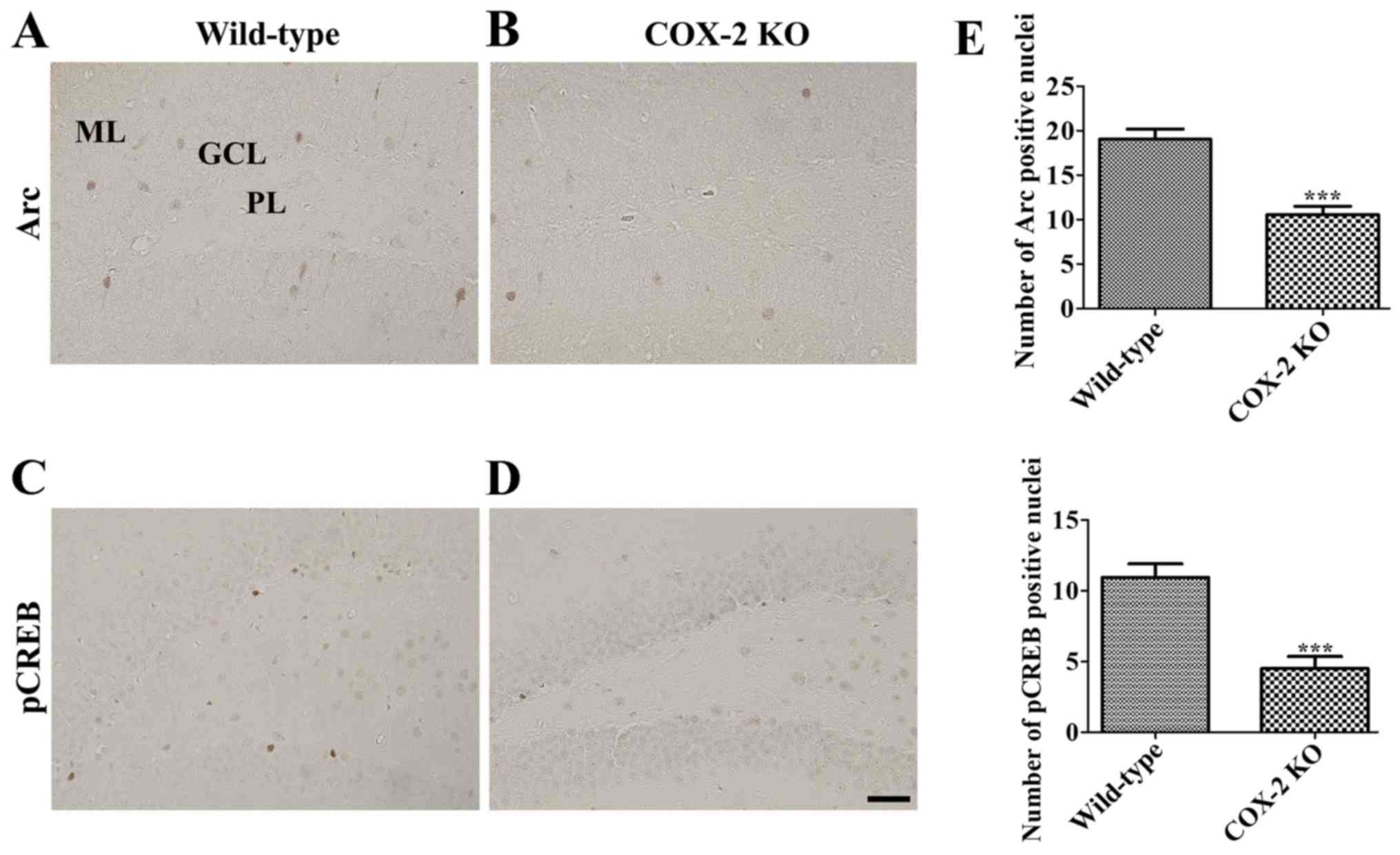|
1
|
Isaacson RL and Pribram KH: The
Hippocampus. 3 and 4. Plenum; New York: 1985
|
|
2
|
Bayer SA: Development of the hippocampal
region in the rat. II. Morphogenesis during embryonic and early
postnatal life. J Comp Neurol. 190:115–134. 1980. View Article : Google Scholar : PubMed/NCBI
|
|
3
|
Schlessinger AR, Cowan WM and Gottlieb DI:
An autoradiographic study of the time of origin and the pattern of
granule cell migration in the dentate gyrus of the rat. J Comp
Neurol. 159:149–175. 1975. View Article : Google Scholar : PubMed/NCBI
|
|
4
|
Yoo DY, Yoo KY, Choi JW, Kim W, Lee CH,
Choi JH, Park JH, Won MH and Hwang IK: Time course of postnatal
distribution of doublecortin immunoreactive developing/maturing
neurons in the somatosensory cortex and hippocampal CA1 region of
C57BL/6 mice. Cell Mol Neurobiol. 31:729–736. 2011. View Article : Google Scholar : PubMed/NCBI
|
|
5
|
Jung HY, Yim HS, Yoo DY, Kim JW, Chung JY,
Seong JK, Yoon YS, Kim DW and Hwang IK: Postnatal changes in
glucose transporter 3 expression in the dentate gyrus of the
C57BL/6 mouse model. Lab Anim Res. 32:1–7. 2016. View Article : Google Scholar : PubMed/NCBI
|
|
6
|
Yoo DY, Yoo KY, Park JH, Choi JW, Kim W,
Hwang IK and Won MH: Detailed differentiation of calbindin
D-28k-immunoreactive cells in the dentate gyrus in C57BL/6 mice at
early postnatal stages. Lab Anim Res. 27:153–159. 2011. View Article : Google Scholar : PubMed/NCBI
|
|
7
|
Kujubu DA, Fletcher BS, Varnum BC, Lim RW
and Herschman HR: TIS10, a phorbol ester tumor promoter-inducible
mRNA from Swiss 3T3 cells, encodes a novel prostaglandin
synthase/cyclooxygenase homologue. J Biol Chem. 266:12866–12872.
1991.PubMed/NCBI
|
|
8
|
O'Banion MK, Winn VD and Young DA: cDNA
cloning and functional activity of a glucocorticoid-regulated
inflammatory cyclooxygenase. Proc Natl Acad Sci USA. 89:4888–4892.
1992. View Article : Google Scholar : PubMed/NCBI
|
|
9
|
Yagami T, Koma H and Yamamoto Y:
Pathophysiological roles of cyclooxygenases and prostaglandins in
the central nervous system. Mol Neurobiol. 53:4754–4771. 2016.
View Article : Google Scholar : PubMed/NCBI
|
|
10
|
Sang N, Zhang J, Marcheselli V, Bazan NG
and Chen C: Postsynaptically synthesized prostaglandin E2 (PGE2)
modulates hippocampal synaptic transmission via a presynaptic PGE2
EP2 receptor. J Neurosci. 25:9858–9870. 2005. View Article : Google Scholar : PubMed/NCBI
|
|
11
|
Endres M, Dirnagl U and Moskowitz MA: The
ischemic cascade and mediators of ischemic injury. Handb Clin
Neurol. 92:31–41. 2009. View Article : Google Scholar : PubMed/NCBI
|
|
12
|
Iadecola C, Niwa K, Nogawa S, Zhao X,
Nagayama M, Araki E, Morham S and Ross ME: Reduced susceptibility
to ischemic brain injury and N-methyl-d-aspartate-mediated
neurotoxicity in cyclooxygenase-2-deficient mice. Proc Natl Acad
Sci USA. 98:1294–1299. 2001. View Article : Google Scholar : PubMed/NCBI
|
|
13
|
Kirkby NS, Zaiss AK, Urquhart P, Jiao J,
Austin PJ, Al-Yamani M, Lundberg MH, MacKenzie LS, Warner TD,
Nicolaou A, et al: LC-MS/MS confirms that COX-1 drives vascular
prostacyclin whilst gene expression pattern reveals non-vascular
sites of COX-2 expression. PLoS One. 8:e695242013. View Article : Google Scholar : PubMed/NCBI
|
|
14
|
Hewett SJ, Bell SC and Hewett JA:
Contributions of cyclooxygenase-2 to neuroplasticity and
neuropathology of the central nervous system. Pharmacol Ther.
112:335–357. 2006. View Article : Google Scholar : PubMed/NCBI
|
|
15
|
Yamagata K, Andreasson KI, Kaufmann WE,
Barnes CA and Worley PF: Expression of a mitogen-inducible
cyclooxygenase in brain neurons: Regulation by synaptic activity
and glucocorticoids. Neuron. 11:371–386. 1993. View Article : Google Scholar : PubMed/NCBI
|
|
16
|
Jung HY, Yoo DY, Kim JW, Kwon HJ, Lee KY,
Choi JH, Kim DW, Chung JY, Yoon YS and Hwang IK: Age-associated
alterations in constitutively expressed cyclooxygenase-2
immunoreactivity and protein levels in the hippocampus. Mol Med
Rep. 15:4333–4337. 2017. View Article : Google Scholar : PubMed/NCBI
|
|
17
|
Hwang IK, Yi SS, Yoo KY, Park OK, Yan B,
Kim IY, Kim YN, Song W, Moon SM, Won MH, et al: Effects of
treadmill exercise on cyclooxygenase-2 in the hippocampus in type 2
diabetic rats: Correlation with the neuroblasts. Brain Res 1341.
84–92. 2010. View Article : Google Scholar
|
|
18
|
Nam SM, Kim JW, Yoo DY, Choi JH, Kim W,
Jung HY, Won MH, Hwang IK, Seong JK and Yoon YS: Effects of
treadmill exercise on neural stem cells, cell proliferation, and
neuroblast differentiation in the subgranular zone of the dentate
gyrus in cyclooxygenase-2 knockout mice. Neurochem Res.
38:2559–2569. 2013. View Article : Google Scholar : PubMed/NCBI
|
|
19
|
Nam SM, Kim JW, Yoo DY, Choi JH, Kim W,
Jung HY, Won MH, Hwang IK, Seong JK and Yoon YS: Comparison of
pharmacological and genetic inhibition of cyclooxygenase-2: Effects
on adult neurogenesis in the hippocampal dentate gyrus. J Vet Sci.
16:245–251. 2015. View Article : Google Scholar : PubMed/NCBI
|
|
20
|
Hickey RW, Adelson PD, Johnnides MJ, Davis
DS, Yu Z, Rose ME, Chang YF and Graham SH: Cyclooxygenase-2
activity following traumatic brain injury in the developing rat.
Pediatr Res. 62:271–276. 2007. View Article : Google Scholar : PubMed/NCBI
|
|
21
|
Kaufmann WE, Worley PF, Taylor CV, Bremer
M and Isakson PC: Cyclooxygenase-2 expression during rat
neocortical development and in Rett syndrome. Brain Dev. 19:25–34.
1997. View Article : Google Scholar : PubMed/NCBI
|
|
22
|
Tocco G, Freire-Moar J, Schreiber SS,
Sakhi SH, Aisen PS and Pasinetti GM: Maturational regulation and
regional induction of cyclooxygenase-2 in rat brain: Implications
for Alzheimer's disease. Exp Neurol. 144:339–349. 1997. View Article : Google Scholar : PubMed/NCBI
|
|
23
|
Paxinos G and Franklin KBJ: The Mouse
Brain in Stereotaxic Coordinates. Academic Press; San Diego:
2001
|
|
24
|
Breder CD, Dewitt D and Kraig RP:
Characterization of inducible cyclooxygenase in rat brain. J Comp
Neurol. 355:296–315. 1995. View Article : Google Scholar : PubMed/NCBI
|
|
25
|
Breder CD: Cyclooxygenase systems in the
mammalian brain. Ann NY Acad Sci. 813:296–301. 1997. View Article : Google Scholar : PubMed/NCBI
|
|
26
|
Piscopo P, Bernardo A, Calamandrei G,
Venerosi A, Valanzano A, Bianchi D, Confaloni A and Minghetti L:
Altered expression of cyclooxygenase-2, presenilins and oxygen
radical scavenging enzymes in a rat model of global perinatal
asphyxia. Exp Neurol. 209:192–198. 2008. View Article : Google Scholar : PubMed/NCBI
|
|
27
|
Zhang MZ, Wang JL, Cheng HF, Harris RC and
McKanna JA: Cyclooxygenase-2 in rat nephron development. Am J
Physiol. 273:F994–F1002. 1997.PubMed/NCBI
|
|
28
|
Bloomer WA, VanDongen HM and VanDongen AM:
Arc/Arg3.1 translation is controlled by convergent
N-methyl-D-aspartate and Gs-coupled receptor signaling pathways. J
Biol Chem. 283:582–592. 2008. View Article : Google Scholar : PubMed/NCBI
|
|
29
|
Guzowski JF, McNaughton BL, Barnes CA and
Worley PF: Environment-specific expression of the immediate-early
gene Arc in hippocampal neuronal ensembles. Nat Neurosci.
2:1120–1124. 1999. View
Article : Google Scholar : PubMed/NCBI
|
|
30
|
Guzowski JF, Lyford GL, Stevenson GD,
Houston FP, McGaugh JL, Worley PF and Barnes CA: Inhibition of
activity-dependent arc protein expression in the rat hippocampus
impairs the maintenance of long-term potentiation and the
consolidation of long-term memory. J Neurosci. 20:3993–4001. 2000.
View Article : Google Scholar : PubMed/NCBI
|
|
31
|
Holloway CM and McIntyre CK: Post-training
disruption of Arc protein expression in the anterior cingulate
cortex impairs long-term memory for inhibitory avoidance training.
Neurobiol Learn Mem. 95:425–432. 2011. View Article : Google Scholar : PubMed/NCBI
|
|
32
|
Steward O and Worley P: Local synthesis of
proteins at synaptic sites on dendrites: Role in synaptic
plasticity and memory consolidation? Neurobiol Learn Mem.
78:508–527. 2002. View Article : Google Scholar : PubMed/NCBI
|
|
33
|
Kuipers SD, Trentani A, Tiron A, Mao X,
Kuhl D and Bramham CR: BDNF-induced LTP is associated with rapid
Arc/Arg3.1-dependent enhancement in adult hippocampal neurogenesis.
Sci Rep. 6:212222016. View Article : Google Scholar : PubMed/NCBI
|
|
34
|
Meconi A, Lui E and Marrone DF: Sustained
Arc expression in adult-generated granule cells. Neurosci Lett.
603:66–70. 2015. View Article : Google Scholar : PubMed/NCBI
|
|
35
|
Langston RF, Ainge JA, Couey JJ, Canto CB,
Bjerknes TL, Witter MP, Moser EI and Moser MB: Development of the
spatial representation system in the rat. Science. 328:1576–1580.
2010. View Article : Google Scholar : PubMed/NCBI
|
|
36
|
Kaufmann WE, Worley PF, Pegg J, Bremer M
and Isakson P: COX-2, a synaptically induced enzyme, is expressed
by excitatory neurons at postsynaptic sites in rat cerebral cortex.
Proc Natl Acad Sci USA. 93:2317–2321. 1996. View Article : Google Scholar : PubMed/NCBI
|
|
37
|
Hardingham GE, Fukunaga Y and Bading H:
Extrasynaptic NMDARs oppose synaptic NMDARs by triggering CREB
shut-off and cell death pathways. Nat Neurosci. 5:405–414. 2002.
View Article : Google Scholar : PubMed/NCBI
|
|
38
|
Hardingham GE and Bading H: Synaptic
versus extrasynaptic NMDA receptor signalling: Implications for
neurodegenerative disorders. Nat Rev Neurosci. 11:682–696. 2010.
View Article : Google Scholar : PubMed/NCBI
|
|
39
|
Parsons MP and Raymond LA: Extrasynaptic
NMDA receptor involvement in central nervous system disorders.
Neuron. 82:279–293. 2014. View Article : Google Scholar : PubMed/NCBI
|
|
40
|
Nacher J and McEwen BS: The role of
N-methyl-d-aspartate receptors in neurogenesis. Hippocampus.
16:267–270. 2006. View Article : Google Scholar : PubMed/NCBI
|
|
41
|
Bursztajn S, Falls WA, Berman SA and
Friedman MJ: Cell proliferation in the brains of NMDAR NR1
transgenic mice. Brain Res 1172. 10–20. 2007. View Article : Google Scholar
|
|
42
|
Kitamura T, Mishina M and Sugiyama H:
Enhancement of neurogenesis by running wheel exercises is
suppressed in mice lacking NMDA receptor epsilon 1 subunit.
Neurosci Res. 47:55–63. 2003. View Article : Google Scholar : PubMed/NCBI
|
|
43
|
Hewett SJ, Shi J, Gong Y, Dhandapani K,
Pilbeam C and Hewett JA: Spontaneous glutamatergic synaptic
activity regulates constitutive COX-2 expression in neurons:
Opposing roles for the transcription factors CREB (cAMP response
element binding) protein and Sp1 (stimulatory protein-1). J Biol
Chem. 291:27279–27288. 2016. View Article : Google Scholar : PubMed/NCBI
|
|
44
|
Gonzalez GA, Yamamoto KK, Fischer WH, Karr
D, Menzel P, Biggs W III, Vale WW and Montminy MR: A cluster of
phosphorylation sites on the cyclic AMP-regulated nuclear factor
CREB predicted by its sequence. Nature. 337:749–752. 1989.
View Article : Google Scholar : PubMed/NCBI
|
|
45
|
Codocedo JF and Inestrosa NC:
Wnt-5a-regulated miR-101b controls COX2 expression in hippocampal
neurons. Biol Res. 49:92016. View Article : Google Scholar : PubMed/NCBI
|
|
46
|
Bian WJ, Miao WY, He SJ, Wan ZF, Luo ZG
and Yu X: A novel Wnt5a-Frizzled4 signaling pathway mediates
activity-independent dendrite morphogenesis via the distal PDZ
motif of Frizzled 4. Dev Neurobiol. 75:805–822. 2015. View Article : Google Scholar : PubMed/NCBI
|
|
47
|
Farías GG, Alfaro IE, Cerpa W, Grabowski
CP, Godoy JA, Bonansco C and Inestrosa NC: Wnt-5a/JNK signaling
promotes the clustering of PSD-95 in hippocampal neurons. J Biol
Chem. 284:15857–15866. 2009. View Article : Google Scholar : PubMed/NCBI
|
|
48
|
Ma Y, Matsuwaki T, Yamanouchi K and
Nishihara M: Cyclooxygenase-2-related signaling in the hypothalamus
plays differential roles in response to various acute stresses.
Brain Res 1508. 23–33. 2013. View Article : Google Scholar
|
|
49
|
Ma Y, Matsuwaki T, Yamanouchi K and
Nishihara M: Glucocorticoids suppress the protective effect of
Cyclooxygenase-2-related signaling on hippocampal neurogenesis
under acute immune stress. Mol Neurobiol. 54:1953–1966. 2017.
View Article : Google Scholar : PubMed/NCBI
|















